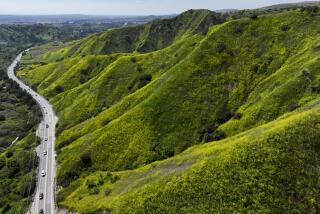The Water Picture: 1986-1993
- Share via
The record California dry spell has ended with a deluge. The 1993 rain total is still a few inches from surpassing the record set in 1978, but it has been enough to refill the state’s network of reservoirs and assure Californians of a reliable water supply--at least until the next dry spell. Here is a look at the rainfall picture since the drought began.
After six years of below-normal rainfall, precipitation is approaching near record levels...
STATEWIDE PRECIPITATION, PERCENT OF NORMAL 1977: 4.5% 1986: 128% 1987: 61% 1988: 82% 1989: 86% 1990: 69% 1991: 76% 1992: 86% 1993: 155% . . . replenishing reservoirs that were getting dangerously low.
*
RESERVOIR STORAGE, PERCENT OF NORMAL 1977: 35% 1986: 119% 1987: 84% 1988: 66% 1989: 74% 1990: 60% 1991: 61% 1992: 56% 1993: 87% Meanwhile, the snowpack in the eastern Sierra assures adequate water supplies for the first time in years.
SNOWPACK WATER CONTENT, PERCENT OF NORMAL 1977: 27% 1986: 188% 1987: 47% 1988: 40% 1989: 72% 1990: 43% 1991: 85% 1992: 68% 1993: 140% Notes: 1993 figures are year-to-date totals, except snowpack, which is an estimate of what the April 1 season total will be.
Sources: California Drought Information Center, L.A. Department of Water and Power
DROUGHT CHRONOLOGY
April, 1988: In a second consecutive critically dry year, Gov. George Deukmejian’s chief water adviser, David N. Kennedy, declares a drought in California.
March, 1990: Faced with a water shortage of nearly 50%, Santa Barbara enacts a tough law to ban lawn-watering. Several other cities throughout the state enact conservation measures.
April, 1990: The Los Angeles Department of Water and Power institutes water-saving efforts, including creating teams of roving “drought busters.”
May, 1990: Santa Barbara residents try alternatives to green lawns, such as painting brown lawns green and putting in green concrete.
May, 1990: Mayor Tom Bradley unveils a mandatory water rationing plan.
July, 1990: Los Angeles City Council approves voluntary rationing and includes the city’s first fines for flagrant wasters.
December, 1990: Metropolitan Water District orders member agencies to start mandatory cuts.
February, 1991: Los Angeles City Council imposes the toughest water rationing measure in the city’s history.
March, 1991: Water rationing begins in Los Angeles, with residents required to cut water use from 1986 levels or face stiff penalties. The MWD, adopting the most drastic conservation measures in its history, votes to cut deliveries to water agencies by 50%. Water officials warn that the “March miracle,” nearly 30 consecutive days of stormy, wet weather, will not reverse the five-year dry spell.
April, 1991: Supervisor Kenneth Hahn endorses a proposal to build a pipeline to import water from Alaska, which is never implemented.
March, 1992: The Santa Barbara City Council declares the drought over in that city, after the National Weather Service declares the drought over in Ventura and southern Santa Barbara counties. The MWD votes to roll back water rationing and other local agencies relax guidelines.
April, 1992: After 13 months of the toughest water conservation efforts in the city’s history, the Los Angeles City Council ends mandatory rationing.
November, 1992: State hydrologists predict a high probability of an unprecedented seventh year of drought, something that has not happened since at least 1560.
Feb. 1, 1993: The DWP officially declares the drought over for the city of Los Angeles.
Feb. 24, 1993: Gov. Pete Wilson declares the drought over for California.
More to Read
Sign up for Essential California
The most important California stories and recommendations in your inbox every morning.
You may occasionally receive promotional content from the Los Angeles Times.













